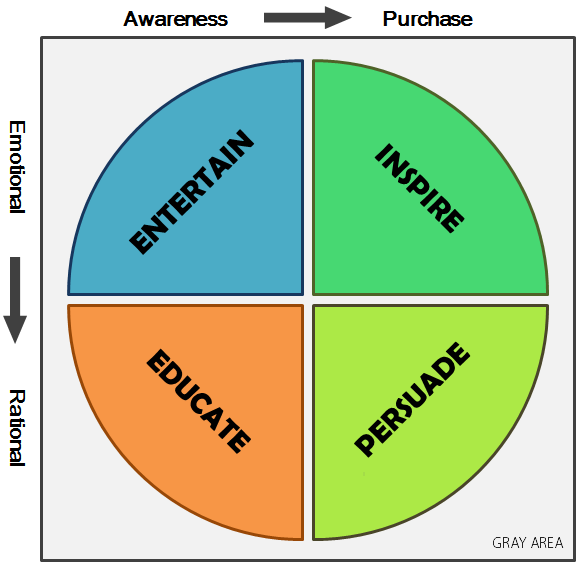Creating Marketing Personas To Improve PPC Experience

With minds constantly clouded by metrics and potential account optimizations, PPC account managers all too often overlook the most critical component in their marketing campaigns — Users. By creating marketing personas we can keep users at top-of-mind and address them throughout the campaign build and optimization processes to prevent any potential oversight.
However you refer to your users, the people that come to your website seeking goods or services are THE driving force behind any and all current and future marketing initiatives. Your website and business both depend on the user, so why not develop a marketing strategy that considers them as well? The user is the single most important element in any PPC campaign, so please don’t make the mistake of forgetting about them when creating campaigns and associated content.
Creating marketing personas isn’t exactly easy, but it also doesn’t need to be complicated. Use what you know about your business goals, your website, and your PPC campaigns to develop different types of personas. Remember, your website doesn’t have just one type of user. There are many and each persona behaves differently. The content you deliver via your PPC campaigns should match the personas of users you expect to engage with your ads. The end result will be a quality user experience and improved conversion rates.
So how do we get started creating marketing personas?
Marketing Personas Depend on Conversion Phase & Decision-Making
Marketing personas have been around for awhile, but for this post, I’ve approached the concept through the lens of paid search campaigns. At the most basic level marketing personas are derived from two factors: interest and reason. We can use stages in the conversion funnel – awareness to purchase – to represent a user’s level of interest. We can use the types of decisions people make – emotional or rational – to represent reason. Every visitor to your site can be represented by some combination of these factors.
This is most easily illustrated with a beautiful chart. This chart helps visualize how these factors combine in different ways to create marketing personas:

Delivering the right message at the right time will be critical to developing an appropriate marketing strategy. Some users might be discovering your product for the first time. Other users might be comparison shopping. Yet others might be making a purchase right now. Whichever it may be, your marketing message and associated on-site content needs to match the qualities and intent of each persona to build a quality user experience.
Create Content to Match Intent
This chart is great but let’s dig a little deeper. We’ve started to identify our different marketing personas, but what do we do once a user has reached our website?
The answer you’re looking for is: provide relevant content. Let’s see what type of content each persona expects.

Entertainment-Driven Personas
These types of users are currently in the awareness phase of the conversion funnel and are driven more regularly by emotional triggers. They are typically the least engaged but their value is incredibly high because they are your latest round of candidates. They’ve only come to know your brand very recently and are looking to digest relatively simple types of content.
Focus on these types of content:
- Branded videos
- Quizzes
- Games
- Etc

Inspiration-Driven Personas
These users have moved past the awareness stage and are ready to complete a purchase on your website though they are still tend to make decisions based on emotional response. They are looking for cues from outside sources to motivate them to complete the purchase.
Focus on these types of content:
- Reviews
- Community forums
- Celebrity endorsements
- Etc

Education-Driven Personas
These users are rational decision-makers but are in an awareness phrase. They have a strong need to learn about a product before they will even consider moving further along the conversion funnel.
Focus on these types of content:
- Infographics
- Press releases
- Guides & manuals
- Etc

Persuasion-Driven Personas
Of all the marketing personas mentioned here, these are the most likely to convert. They are in a position to buy and have made all rational decisions leading up to now. Support your product or service purchase with detailed information about the product or service.
Focus on these types of content:
- Case studies
- Webinars
- Data sheets
- Etc

Personas Falling into the Gray Areas
In a perfect world every user would fall neatly into the buckets mentioned above; however, a perfect world this is not. Users are frequently transitioning back-and-forth between user personas. This isn’t necesarily a bad thing.
Part of your job, a large part, is to move users from one persona to the next, constantly making them more comfortable with their eventual choice to work with you. Strive to move users from an emotional state-of-mind to a rational one. Urge visitors to move closer to purchase as the become more aware of your products and services.
Naturally there is content to support these gray areas:
- Articles or eBooks can be presented to users between entertainment-driven and education-driven mentalities.
- Demo videos or reports can be supplied to someone between an education-driven and persuasion-driven mindset.
- Events or ratings can both inspire or persuade users.
So… What About PPC?
Consider the marketing personas we’ve just covered when creating and optimizing your paid search campaigns in order to create a robust, interactive advertising experience. We can build campaigns meant to target different personas by closely examining our keywords, ad copy and landing page content and matching them to different audience types.
Keywords & Intent
Locate or create keywords that expressly declare user intent and the content they wish to find. Meaning, does the keyword text actually use words like guide, video, whitepaper, buy, press release, or forum? Simply stated, if a user tells you exactly what they want, then give it to them.
That’s all fantastic, but what happens when the keyword is more obscure and the user doesn’t expressly declare their intent? In these cases we can’t associate the user to any particular persona. Let’s look at an example: kayak lessons. This is a fairly ambiguous keyword and we can’t say with 100% certainty what the intent is. We could very easily focus on any combination of personas.
Selecting a particular persona-driven strategy – entertain, inspire, educate, or persuade – isn’t clear. So we must test and optimize.
Test Copy & Deliver Content Based on the Data
Think about business goals and test different content that might appeal to a variety of personas. Let’s say, in my kayaking example, that I want to put equal focus on each of my personas. I’d like visitors to view a particular video about my brand of kayak tours because I can easily put equal emphasis on each of my personas. I’d write an ad and build a landing page to support this goal:
Kayak Lessons
Stephen’s Kayak Tours.
See Where We’ll Take You.
www.stephenskayak.com

Now, let’s say my test failed and very few visitors chose to watch the video. It would seem that my keyword, kayak lessons, does not appeal to the entertainment persona. At this point I need to learn more about my visitors. I would turn to my behavior metrics and visitor flow reports to learn what other ways users are interacting (or not interacting) with the page. If I find that a large percentage of visitors click elsewhere on the page, the “store” link for example, I would consider testing a new strategy because my data suggests that a different persona type is interacting with my advertising material. In this case, I would shift toward a focus on education or persuasion.
If a large rate of users are watching the video… great! My test was successful and my strategy was seemingly effective. I would still want to explore the data further to see how users interact with the website after they watch the video to see if the user persona is changing based on website interaction. Do they watch more videos? Do they visit the store? Do they leave the website entirely? Each of these interactions hints at a change in persona.
We can see in these examples how creating marketing personas plays a large role in optimizing paid search campaigns for user experience. Understanding intent and delivering the correct content based on different user identities will take your PPC campaigns to a new level. Users will be happy and your business should be too.


